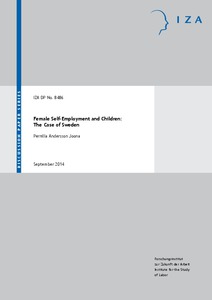Female self-employment and children: the case of Sweden
"Previous studies, mostly from Anglo-Saxon countries, find a positive correlation between the presence of young children in the household and self-employment probabilities among women. This has been seen as an indication of women with young children choosing self-employment as a way of balancin...
| Main Author: | |
|---|---|
| Institution: | ETUI-European Trade Union Institute |
| Format: | TEXT |
| Language: | English |
| Published: |
Bonn
2014
IZA |
| Subjects: | |
| Online Access: | https://www.labourline.org/KENTIKA-19116229124919344019-Female-self-employment-and-chi.htm |
| Summary: | "Previous studies, mostly from Anglo-Saxon countries, find a positive correlation between the presence of young children in the household and self-employment probabilities among women. This has been seen as an indication of women with young children choosing self-employment as a way of balancing work and family commitments. This paper studies the relationship between children and female self-employment in a country with family friendly policies and a generous welfare system: Sweden. The initial hypothesis is that we will not find evidence of a positive effect of children on self-employment among Swedish women since there are other institutions in place aiming at facilitating the combination of work and family. Using Swedish register data for the period 2004-2008 we do, however, find that the presence of young children increases the probability of choosing self-employment also among Swedish women. The effect is strongest for women with very young children, 0-3 years of age. These results also hold in a panel data model that takes individual unobserved heterogeneity into account. We also analyze time-use data and find, contrary to what has been found in many other countries, that self-employed women spend more, or as much, time on market work than wage-earning women. This raises doubts about whether women in Sweden chose self-employment as a way of balancing work and family commitments. We suggest an alternative interpretation which is that women who chose self-employment while the children are young in fact are women with strong preferences for market work." |
|---|---|
| Physical Description: | 37 p. Digital |

